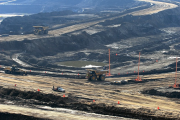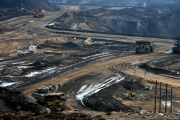Back in the early 1970s, the Alberta government effectively made a Faustian bargain. It allowed the oilsands industry to keep on mining, despite the sector not knowing how to clean up its fluid tailings waste — the assumption being that future technologies would solve the problem. Unfortunately, no silver bullets have been discovered, and the industry has kicked the can down the road on this mess for the last 50 years. In the meantime, the oilsands’ tailings ponds have grown so massive they impound a globally unprecedented 1.3 trillion litres of toxic waste. These tailings are unlike any other industrial by-product in the world; they contain residual hydrocarbons, a cocktail of toxic chemicals, and fine particles of clay and silt that remain suspended for centuries in a sort of artificial quicksand.
Now this concerning trend is set to continue on for decades, with the Alberta government’s approval in late October of a dubious new plan to manage tailings at Suncor’s Base Plant Mine. The oldest of all the oilsands mines, the Base Plant started operations in 1967 and is now set to close in 2033. So far, the mine has accumulated enough molasses-like sludge to fill 100,000 Olympic swimming pools. This volume constitutes a quarter of the entire industry’s total fluid tailings inventory.
As a condition of their original operating licences, mining companies promised to clean up and return these sites to the Crown after operations cease. However, by approving Suncor’s plan, the government is certainly testing the meaning of this promise. Based on the plan, Suncor now has 70 years after the mine closes (and revenues have ceased) in 2033 to finish cleaning up the tailings and return the land. The plan also lets Suncor use a reclamation “technology” called water capping, wherein most of the mine’s tailings inventory will be placed in a mined-out pit and covered with water to form a permanent artificial lake. This approach is unproven for managing oilsands tailings, and could leave local stakeholders to deal with a legacy of toxicity in the environment and the public on the hook for perpetual monitoring costs.
The Suncor plan’s approval underscores the fact that oilsands tailings remain an enormous environmental problem that is projected to continue escalating in the coming decades. Open tailings ponds now cover over 250 square kilometresof the northern Alberta landscape, an area equivalent to 62 Stanley Parks (in Vancouver). And, if current proposals on the books are approved, the government will effectively give the green light for these tailings to continue grow to 1.5 trillion litres over the next 20 years. This stands in stark contrast to public statements by industry leaders and a procession of former Alberta premiers between 2009 and 2013 that tailings ponds were shrinking and on track to soon disappear from the landscape entirely.
This grim situation should deeply concern all Canadians. By allowing oilsands tailings ponds to continue to grow, the Alberta government is signing up all of Canada for decades of further uncertainty and risk. If any of these ponds were to breach, an unimaginable environmental disaster would result, affecting the Mackenzie River Basin as far as the Arctic Ocean. Moreover, according to recent estimates by Environmental Defence Canada, these ponds represent as much as $50 billion in total clean-up costs — of which only $1.3 billion is held in securities. All of the major political parties in Alberta seem strangely quiet on one of the largest fiscal issues facing the province. Should the oilsands mining sector face bankruptcies in the coming decades, the environmental and fiscal liability of these ponds would inevitably become a burden borne by Albertan and Canadian taxpayers.
We must face the uncomfortable reality that the future economic viability of oilsands mining in the context of the 21st-century global energy transition is uncertain at best. It follows that companies must be held accountable for addressing their environmental impacts today, while they are still around to do so. After five decades of procrastinating, the time has come for the Alberta government to finally step up and lift the substantial weight of these liabilities off the shoulders of Canadians.
This op-ed originally appeared on iPolitics.






